Regional & Community Empowerment Project (RCEP)
Presented by: Dr. Andrew Skadberg, May 13, 2010Introduction
Dr. Skadberg is pleased to present a regional based approach for rural tourism and innovative agricultural development. The approach has been developing during the last 12 years and can be adapted to any region.
However, as with most governmental jurisdictions, whether it is in the United States or in developing places, a significant challenge arises regarding coordination of organizational efforts and to realize the full potentials of tourism while maintaining a strong, diverse agricultural economy. This proposal describes our recommendations for how to develop tourism while at the same time empowering rural communities and their citizens to expand their economy (especially agricultural) of the region/country. At the same time, careful considerations are made for an holistic approach to protect the environmental, historical and cultural characteristics of the communities and the region.
As a result of our research we have identified three primary “Initiatives” (Diagram 1) to comprise the Regional and Community Empowerment Project (RCEP). These Initiatives will best be developed simultaneously and in a harmonious fashion. Each of these Initiatives are described in detail later in this document. An introduction to these initiatives are:
Initiative I – Education: Tourism, Agricultural and Community Economic Diversification Institute—the “TACED Institute” for tourism and value-added agricultural technical assistance. (The Institute could be sponsored by a non-profit or philanthropic organization”)
As depicted in diagram 2, this part of the initiative is associated with TACED Institute that will provide access to information and technical assistance to the region with an entrepreneurial focus. The TACED Institute will support a holistic economic development strategy focused on tourism, innovation in agriculture and small business development. Dr. Skadberg has access to considerable educational materials targeting rural economic development. The TACED Institute will be comprised of an institutional (physical location) and a Web based distance learning resource to be accessed through “partner” organizations (e.g. universities, Internet cafes and/or community and school computer centers/classrooms). Additionally the TACED Institute will provide on-site, hands-on training seminars to local “trainers” to create a network of “tech-transfer associates” throughout the region. It is our preference to partner with regional universities to develop educational outreach programs.
Initiative
II –
Branding/Marketing: “Experience Your Region” regional tourism
destination
branding (national and internationally
marketed). – the actual “brand/trademark” will
be
developed from the initiative itself.
Develop the region regional branding to be marketed both nationally and internationally as “Experience Your Region”, as an experiential tourism destination. The purpose of this initiative is to expand experiential tourism in the region based on existing tourism destinations and attractions and those that potentially will develop, in addition to the existing and developing infrastructure. Observing trends around the globe, any region has potential for successful tourism when the focus is regional and on the broader base offered through experiential/rural tourism. “Experience Your Region” will develop the connections between the various attractions, will create the marketing tools and brand, and will provide the travel and tourism services to grow this potential market.
Initiative
III
Developing New Technologies:
Traveler Information Centers—
Internet access portals (wireless
Internet portals, kiosks) – Traveler Tourism
and Community Network – the
actual name of the network will be
developed out of the
initiative.
The purpose of the Traveler Tourism and Community Network (Traveler Network) is to provide: 1) a complete “package” of answers to questions that traveler’s might have, 2) customized information about the places they are traveling through, and 3) support for rural communities and small businesses to market themselves. The intent of the Traveler Network is to help regions and communities be better hosts to visitors and do a better job of “Marketing Your Region”. In addition, the Traveler Network can provide dynamic, interesting and timely information to users at locations where it is not practical to have staff to serve people.
Some important concepts for this three-initiative project are embracing a Creative, Holistic and Sustainable Development and the key concerns include:
- Tourism and agricultural innovation must be developed in the context of existing economy.
- The local region/communities must be the “owners”!
- New development must be complimentary, and enhance quality of life.
- The Project must protect the natural, cultural, social and historical resources.
- Diversity is paramount, any single industry economy is risky – even tourism.
- Most important factor in the new tourism economy—EXPERIENCE (Authentic, Real, Quality).
- Innumerable regions are primed for success – because they have strong agricultural economies and robust business sectors.
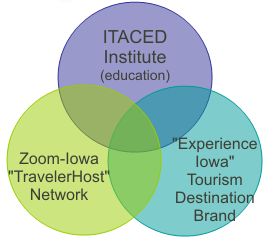
Diagram 1: The Three Initiatives of the Regional & Community and Empowerment Project (education, marketing, technology)
Potential Collaborators
Sponsoring
philanthropic organizations (e.g. families or non-profits)
Tourism
agencies
Agricultural
agencies
Educational
agencies
Regional Universities and Agencies
Dr.
Skadberg
World
Reverence for Life
University
Web
Antiphon
Cultural
Fusion
The
Moods Channel
Media
sources
AgeofExperientialism.com
IAmSharing.com

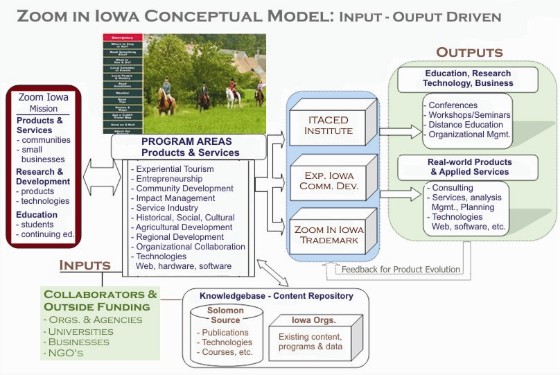
Diagram 2: The “Experience Your Region” Conceptual Model—Inputs and Outputs
Introduction to Vision, Guiding Principles and Important Project Concepts
Prior to presenting the specifics of each of the three initiatives it is important to provide four theoretical principles for a project of this sort. These principles are:
Guiding Principle 1) Strong overall vision and conceptual foundationGuiding Principle 2) Systems thinking – understanding context
Guiding Principle 3) The Experiential-Service Model – Next Generation Education
Guiding Principle 4) The Network – creating critical mass and supporting via technologies
Guiding Principal 1) Strong Overall Vision and Conceptual Foundation
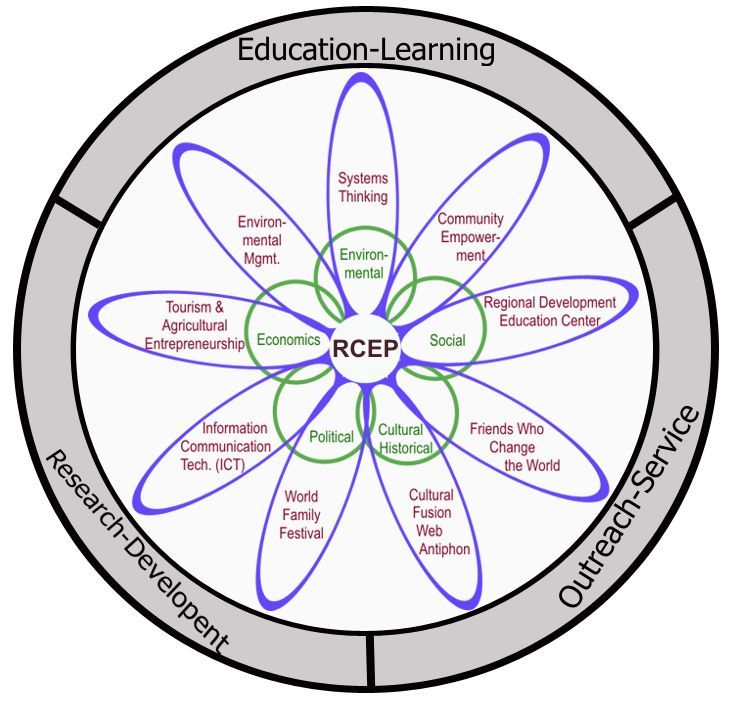
Diagram 31: The Nuclear Reaction – or The Mandala (Lotus Flower): “when a critical mass of knowledge and energy is reached, the results can touch the world”.
The
Center of this image represents the core “nucleus” of the RECP which
will be
represented most significantly by the RCEP Institute. The five “green”
circles
represent the “context” in which the project works in a community /
region /
country. The RCEP team recognizes that the world has been cut up into
pieces by
our scientific and human-oriented (separatist) perspectives. Depicting
the
general categories of disciplines (environmental, social,
cultural/historical,
political, economics) in the five inner circles in Diagram 3 will allow
us to
re-cognize the integral relationship of these pedagogical domains,
providing a
new context for re-aligning our efforts for a successful rural economic
empowerment
strategy. The RCEP, as it develops its programs, will take into account
each of
these areas. Yet we recognize that the lines drawn between these
“disciplines”
are only a functional or organizational delineation established by
historical
and contemporary authorities. In fact, as stipulated in Systems
Thinking, there
is a desperate need to re-examine and recombine these perspectives into a
comprehensive whole after study or examination.
1. We memorialize the inspiration for our “lotus flower” (or mandala) to Dr. Richard Ewing. Dr. Ewing was the Vice President for Research at Texas A&M University until Dec. 5, 2007. Thank You Dr. Ewing.
The “petals of the flower” in Diagram 3 depict the “outreach-service” delivery mechanism of the RCEP. Our emphasis on Outreach-Service (extension) is developed from the Land Grant University System that was so powerfully transformative in the United States. However, we agree with John Campbell’s2 critique of the limitations of the Land-grant system as it has matured, mainly that the “Outreach” not been properly expanded and utilized. Diagram 3 is a symbolic metaphor of a “nuclear reaction”, which is our vision to powerfully extend the learning and research of RCEP to re-connect education to the world, which is depicted in the outer ring of Diagram 3.
It is beyond the scope of this document to discuss all of the benefits of utilizing/revitalizing the land-grant model while empowering it with information communication technologies (ICT), however, in brief, this
approach
will re-vitalize the educational experience for students. It will also
connect RCEP
to the mainstream of society, delivering a multitude of benefits:
essentially
creating a recursive flow of ideas, information, people and business to a
world
that is clamoring for these outputs of our educational system. The outer
ring
of Diagram 3 shows the original vision of the Land-grant model which
framed the
educational system on three legs (Education, Research, Outreach). We add
to the
model the ultimate outputs of this inspired model – Learning,
Development, and
Service.
The
purpose of the Regional and Community Empowerment Project (RCEP) is to
stimulate creative innovation in the economy through the creation of an
experiential learning institution (see Diagram 6). We will begin with a
core educational
program derived from our team’s broad based experience. Delivery will be
supported by state-of-the-art hardware and software infrastructure. Our
“faculty” is strongly connected to excellent colleagues, experts and
practitioners around the world. Working together, they can produce a
unique experiential,
multidisciplinary, international institution that will excel in
education,
research and outreach. Students will be able to expand their horizons
enormously in this virtual and on-site learning environment.
2. President Emeritus, Oklahoma State University – author “Reclaiming a Lost Heritage: Land-grant and Other Higher Education Initiatives of the 21st Century.
Guiding Principle 2) Systems Thinking – Understanding Context
Effective strategies in every human endeavor require that “context” be considered. In short, Systems Thinking aims to “contextualize” things and endeavors to steer clear of simple multi-disciplinary models. No project can be properly developed without carefully considering the context and repercussions of the proposed effort or change. This fact has been recognized for some time in the United States for governmental projects. All federally authorized projects require that environmental impact assessments (EIA) be conducted. EIA are a derivative of Systems Theory. Traditionally associated with large engineering or infrastructural projects, the EIA process has been developed because many human endeavors have resulted in tremendous human, environmental and societal impacts.
Gharajedaghi, 2006, describes “Systems Thinking” in extensive detail in “Systems Thinking: Managing Chaos & Complexity, a Platform for Designing Business Architecture”. And it is beyond the scope of this proposal to discuss at length, however, in short, all endeavors should give serious consideration to the potential environmental, social, political, economic, and cultural/historical repercussions and implications as they interact in the human-natural environment.
As an economic, social and educational endeavor, the RCEP should similarly consider the macro-scale impacts since education is paramount in its influences in shaping future societies. However, we would also include two other “micro”- considerations that might best be termed human and spiritual as they relate to the foundations of our efforts to stimulate individual, personal empowerment that will then convert to community advancement.
Our strategy, discussed in greater detail below, is derived from the basic understanding that successful strategies for education require that we comprehend the opportunity space objectively and comprehensively. The overarching theoretical approach of Systems Thinking that we use as Guiding Principle 2 for the RCEP has been used in numerous complex governmental and private settings (Gharajedaghi, 2006). A few of these settings include ALCOA, Chrysler Corp., Ford Motor Company, and two internationally acclaimed projects: New Economic Order, a United Nations project and Goals for Mankind, a Club of Rome project.
In general, historically and traditionally, human endeavors and scientific research (under the rubric of education) have tended to focus on independent multi-disciplinary pieces in which the whole is the sum of its associative parts. In our systems approach, we intend to look at the “big-picture”, identify and examine the various pieces, reassemble the “puzzle,” (Diagram 4) and then study it as an interactive system—a synthesis of processes (e.g. adoption diffusion), people, and subsystems which are the key to successful education. Evaluation is a critical element which is inherent throughout the process.
The complexity of endeavors to serve human needs effectively, efficiently and responsibly demands that a dynamic and adaptive approach be used. Systems Theory (or Thinking) provides a strong foundation for such an approach. Systems Thinking does not simply entail a multi-disciplinary approach; rather, the real issues related to dynamic and changing situations involving human systems and services is to develop ways to synthesize separate findings into a coherent whole. This fact is far more critical than the ability to generate information from different perspectives. To illustrate our point, we use the elephant story found in Persian literature as narrated by Molana Jaladedin Molavi (Rumi). It presents the elephant story as a metaphor in which several men are attempting to identify the creature in the dark. The effort proves fruitless until another man shows up with a light. Gharajedaghi (2006) Page 108-109 presents this perspective in the following:
“The light, which in this context is a metaphor for methodology, enables them all to see the whole at last.
Rumi’s version of the story means that the ability to see the whole somehow requires an enabling light in the form of an operational systems methodology.” …. For our purpose here, … “one should be able to make one’s underlying assumptions about the nature of the socio-cultural systems explicitly known and verifiable to oneself.
Whatever the nature of the enabling light, my contention is that it must have two dimensions. The first dimension is a framework for reality, a system of systems concepts to help generate the initial set of working assumptions about the subject. The second dimension is an iterative search process to: 1) generate the initial working assumptions, 2) verify and/or modify initial assumptions, and 3) expand and evolve the emerging notions, until a satisfactory vision of the whole is produced. As Singer put it “Truth lies at the end, not at the beginning of the holistic inquiry” (Singer, 1959).
The challenges presented by modern education and its inadequate performance suggest that we consider “stepping-back” to gain new insights to develop solutions and more effective approaches. Based on our team’s direct and personal experiences in education at all levels, our approach is well grounded. The effective and efficient use of available information is a critical input for any model—analytical or systemic.
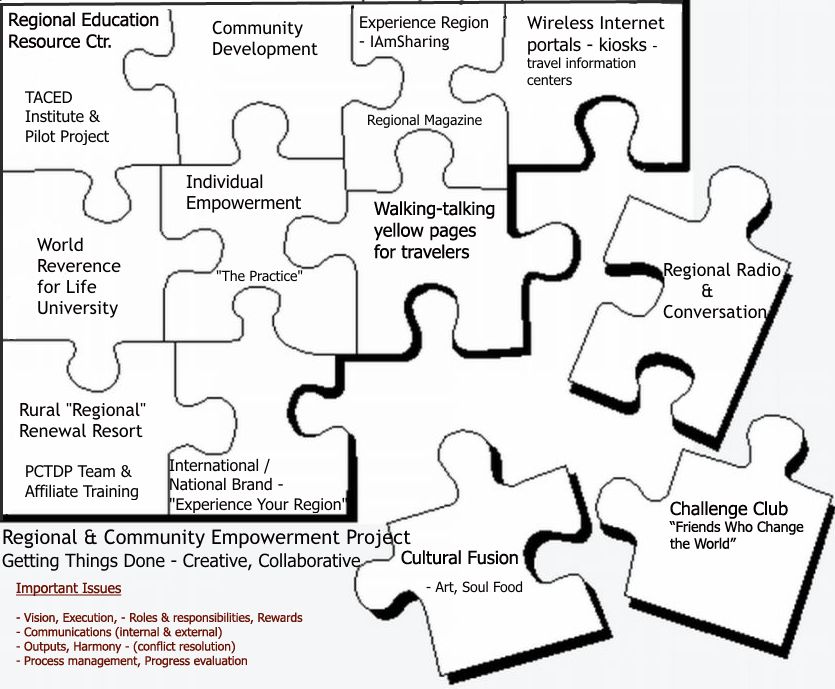
Diagram 4: The puzzle – a functional diagram for understanding context.
Diagram 4 provides an important conceptual tool for understanding that every endeavor that takes place at a regional scale (or likely any scale) will have many different “pieces to the puzzle”. It is important that the “tools” that we use for our systems approach not distract or confuse us. Using a puzzle image provides a simple, yet effective way to visualize context.
In Diagram 4 is a preliminary set of functional components of a “generic” Regional Community Empowerment Project (RCEP). Each piece of the puzzle is critical to manifest the vision (the puzzle picture). It is necessary to identify the separate pieces because the functional aspects of the various puzzle pieces are different. Each puzzle piece has its own set of steps in order to accomplish that function. Additionally, a different set of individuals will likely be responsible for different pieces of the puzzle, however, all of the pieces need to be developed in a coordinated fashion.
This diagram is only a conceptual model since each project will have its own set of functional components (puzzle pieces) based on the organizational and regional context. However, since the Dr. Skadberg´s approach has evolved from real prior or existing projects (e.g. wireless internet portals, Cultural Fusion, etc.), there is a high likelihood that several of these components (pieces of the puzzle) can be used in any RCEP.
The “Important Issues” outline in the bottom left corner of Diagram 4 has been derived from several years of research and experience and defines those issues that Dr. Skadberg sees as critical for success for a RCEP. It is our opinion that managing people inside of organizations and initiatives are the biggest challenge, and proper guidance and policy development provide a solid foundation for success. Thus, this short, but highly critical list identifies how potential pitfalls can be avoided. Things like “vision”, “communications”, organizational “roles and responsibilities” must be seen as paramount for creating a “harmonious” and successful initiative.
Guiding Principle 3) Experiential-Service Model – Next Generation Education
From our assessment of the performance of contemporary educational systems, and a long term view of experiential education and the service (Extension) side of the Land-grant system, we suggest that there is a more dynamic and results oriented model that could be developed and utilized for the RCEP (see Diagram 5). The main objectives of this model are to connect the project benefactors to real-world learning, and also create a better flow of benefits to the public at large.
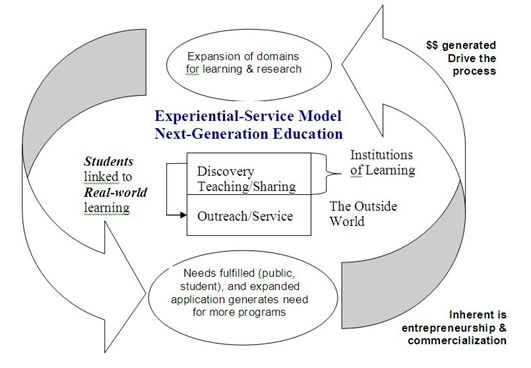
Diagram 5: Depicts the flow of the “Experiential-Service Model, the Next Generation of Education”.
There is a great need of what institutions of higher learning are developing. However the flow of knowledge out of the institution is not adequate. The flow of knowledge (and services) include, but are limited to 1) student practical experience, 2) entrepreneurship/commercialization, and 3) technical assistance with an innovative dynamism outside of traditional pedagogical realms. In our proposed model the institutions of learning would focus on a more interactive (hands-on) discovery approach for Teaching/Learning (Sharing). This would be directly tied to an Outreach/Service function which would make the educational component of the RCEP more applied and also develop a community benefits model that would be perpetually expanding.
The over-arching theme, or driver, would be the needs of communities (businesses, organizations, institutions, individuals) which, when fulfilled, provides incentives for the creation of more programs that fulfill needs and are more benefits based. As more and more students are reached, and the subsequent learning programs are expanded, there will be a resultant expansion of the domains for learning and research.
Additionally the Experiential-Service Model for delivery of educational programs emphasizes “Experiential Learning”. The highlights of this approach are to allow students (constituents) to learn practical skills and knowledge to advance their lives. The “real-world” practicality is derived from providing discovery/learning opportunities from experiences in actual real-world scenarios. This “discovery/teaching/sharing” process then leads to opportunities for “Outreach and Service”. Outreach and active learning in communities leads to fulfilled community “needs” which will naturally evolve to more opportunities to fulfill those needs. The natural outcome of this process is students with more a applied and practical education, and communities being more engaged and informed about what actually is being taught, and how it can benefit them.
A final critical element of the model relates to the emphasis on the educational programs being self-sustaining. The courses/programs being taught should be pertinent and generate enough revenues to support their own continuance. If a course becomes a burden and requires being “subsidized”, than it should be carefully evaluated to be discontinued or replaced by another course/program. Inherent in the process needs to be an understanding that there should be a business model behind this process. Having a guiding principle of “entrepreneurship and commercialization” (or “dream making”) can provide an enhancement of student’s interest in participating in the programs. Instead of seeking funding from institutions and non-profit organizations, the model could be perpetually self supporting if a portion of all business endeavors that develop from the model are fed back to fund the continued growth and development of this new educational paradigm.
Guiding
Principle 4)
The Network – Creating Critical Mass and Supporting via Technologies
Diagram 6 depicts the need to establish a critical mass of attractions in order to attract more visitors and to be able to support an international branding effort for enhancing tourism development. In addition, the pooling of organizational, institutional and community resources enhances capacity building and improves efficiencies and effectiveness due to improved communication and coordination.
Effective coordination is easily accommodated by utilizing Internet Communication Technologies (ICT). Due to the ease of “manifesting” and supporting The Network with ICT tools, we will be better able to support regional networking and collaboration. The model we employ is about cooperation and creativity rather than a competitive model. This focus results in the greatest benefits for the greatest number of people, “the whole is greater than the sum of its parts”.
Diagram 6: Establishing a critical mass of attractions via coordination and technology – (example provided for Iowa)
The following section provides details of the three Initiatives of the Regional and Community Empowerment Project.
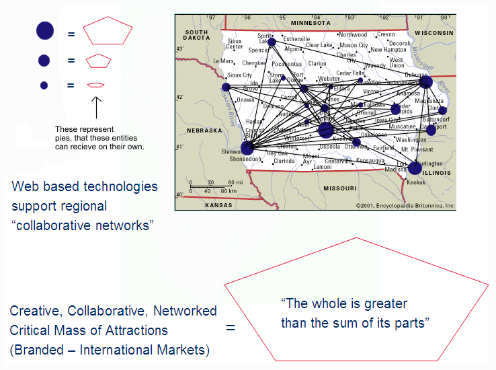
Initiative I. Education: Tourism, Agricultural and Community Economic Diversification Institute—the “TACED Institute” for tourism and value-added agricultural technical assistance
Introduction
As one travels practically every place around the globe and experiences the rich diversity of the natural world and different cultures, it is quite apparent that agriculture and tourism are entirely inter-dependent and must develop in a complimentary fashion. The natural beauty of the countryside and cultural and historical elements of places emerge and become attractive for experiential tourism because of the influence of agriculture. The aim of this proposed project is to recognize the strengths of these two industries and develop strategies to grow opportunities and further diversify economies, based upon existing agricultural necessities. This approach will enhance ecological sustainability by addressing traditional environmental challenges that usually result from economic pressures and improper planning.
Additionally, this proposal recommends the development of new technologies that will facilitate this process and significantly contribute to a new platform for extending education to more people. An added benefit of these technologies are the capabilities to track all aspects of the initiative including educational program success, marketing and business performance.
Initiative I, in short, will build a bridge of benefits to two (and more) woven industries – tourism and agriculture via entrepreneurship, diversification into value-added agriculture and creative business development—in contrast to a competitive approach. The main features of the initiative will build from a) a regional focus, b) the development of cooperatives, and c) adapting successful innovative agricultural initiatives from other places (e.g. Equador, Rwanda Texas A&M project, etc.). Technology and education will be the vehicles for success. A primary result of the RCEP will be to extend educational opportunities to broader and more diverse audiences. The effort will focus on extension outreach programs throughout the region. Once this effort has been developed, tested and evolved, the same process can be taken to other areas and adopted.
Develop a Technical Assistance & Educational Resource Center: Tourism, Agricultural and Community Economic Diversification Institute—(hereafter the TACED Institute) that provides access to information and assistance with an entrepreneurial focus.
Proposed Approach
1)
Aim to enhance a holistic economic development strategy
– tourism (ecotourism, nature, heritage
and cultural tourism, etc.),
agriculture, value-added agriculture, energy, entrepreneurship, micro-
enterprise development.
2)
Adapt existing educational materials through of Dr. Skadberg. (e.g.
Nature
Tourism: A Guidebook for Evaluating Enterprise Opportunities, Developing Tourism in Your
Community, Identifying Community Power Actors, Texas Friendy, etc).
3)
Develop a “custom” entrepreneurial training series (modularized) specific to the
context of the host
community(s) – Dr. Skadberg currently
has developed resources and may partner
with regional universities to develop
educational outreach programs.
4) Develop a custom Rural Community Leadership Program
5)
Create a Web based distance learning portal that could be accessed through
“partner”
universities, Internet cafes and/or
community and school computer centers/classrooms.
- On-site, hands-on training seminars provided by locally trained instructors (using a train-the-trainer) approach supported via Dr. Skadberg (seek sponsorship from Hungarian agencies, non-profit organizations or other entities).
6) Conduct research and project benchmarking throughout the project lifecycle.
Steps in the Process
-
Conduct Strategic Planning session for the TACED Institute strategy workshop –
Identify Project
Board and Key Stakeholders for the
coalition.
- Form working coalition.
- Identify viable sized “region(s)” to initiate project.
- Create short list of prospect communities (regional based preferred – see criteria below).
- Evaluate those communities based on a set of criteria to ensure project success.
-
Resources for the Institute are available and some are in development, or can
be
adopted/integrated from a variety of
sources (e.g. Dr. Skadberg, Extension materials from various
U.S. universities, etc.).
- Identify potential additional funding sources (public & private)
USAID Ford Foundation USDA (etc.) Private Foundations Corporations
-
Dr. Skadberg, Minister and Director of Tourism and others “contextualize” the
approach based on political and social
climate of proposed sites.
- Rural agricultural and forestry regions
- See criteria for selection listed below
Potential Collaborators
- Sponsoring organizations
- Regional (state & national) governmental representatives
- Dr. Skadberg
- Regional University(s)
- IAmSharing
- Antiphon – Cultural Fusion
- Etc.
Outcomes:
- Stimulate/create robust rural community economies
- Sustainability as a driver creating sensible linkages between the various complimentary “assets” and economic sectors within the community/region
- Conserve (and/or enhance) the natural, historical and cultural assets of the community
- Enhance Quality of Life
This initiative aims to integrate all aspects of community economic development into a centralized approach supported by a technology based information and technical assistance – TACED Institute. Publications, information and a variety of rudimentary tools are available to assist communities realize a more diverse set of economic development opportunities. These resources can be combined with new forms of assistance to address other important areas of need including: leadership training & development, tourism development, community enhancement, technology development and utilization, and forest, animal and plant (ecological) protection and enhancement. These areas can be supported via technical assistance and training and other support to stimulate/enhance other economic activities that are necessary for communities to flourish, while also protecting the natural and historical resource base and culture of the region
The approach utilized will provide incentives for the adoption and diffusion of the use of new technologies and distance learning tools and information that is, essentially, universally needed for tourism and other economic development activities. New Web-based technologies can create direct economic returns (rewards) for businesses and communities. These “rewards” then will stimulate people to expand their use of computers for running and growing their businesses and community economic development programs.
An active outreach and “marketing branch” of this initiative will promote resources and services and also conduct in-the-field research to identify and recruit communities that are “primed” with proper leadership and a community collaborative spirit. These communities (or groups of communities) can then be “seeded” with a package of incentives to stimulate their participation.
Because this approach is designed to be market-driven, it will be economically sustainable perpetually. Driven by a successful business development model, programs will be designed to be self-sustaining over time. Initial funds will be used to “prime” the initiative, but the “Institute” will be designed to generate revenues so that the initiative will not need to be subsidized over time.
Pilot Community (Region) Selection Criteria – (tentative and not prioritized)
-
Leadership
-
Creativity
-
Cottage industries
-
Relatively stable economic basis
-
Community agriculture and/or forestry
-
Funding assistance available
-
Diversity of natural resources
-
Critical mass of tourist attractions
-
Linkages between communities (collaborative
potential)
-
Absence of contentiousness intra-community
and inter-community
-
Infrastructure (roads, telecommunications,
service industry e.g. food, lodging)
-
Access to financial support and outside
funding
-
Social networking - capital
-
Access – to tourism attractions by visitors,
distance from University collaborators
-
Prior leadership training
-
Volunteer/service organizations
-
Prior projects that may have potential to
re-start or revitalize
-
Rural development models (existing approaches
– Rwanda/Texas A&M)
Initiative II. Branding/Marketing: “Experience Your Region” – Regional Brand for National and International Markets
Preliminarily, Dr. Skadberg will determine whether a region is well positioned to become a national and international tourist destination. Our group has been actively researching and developing an approach (and a preliminary brand) that will compliment the regional Traveler Network project.
Regional Brand Developed as the “Experience Your Region” brand - The Place, as an international/national tourism destination. The purpose of this is to expand experiential tourism in the region based on the tourism destinations and attractions as well as existing and developing infrastructure. Based on preliminary assessments and economic indicators, experiential/rural tourism in the region offers a robust and expanding market place. Dr. Skadberg and regional contacts will develop the connections between the various attractions, will develop the marketing tools and brand, and will create the travel and tourism services to grow this “opportunity space”.
Steps in the process - tentative
1) Identify products – (e.g. Farm-stay/B&Bs, The Four Elements – Air, Water, Earth, Fire)
2) Develop phased concept for “marketing master-plan” – then answer the question “where do we start first?”
3) Create list of Farm-stay/B&Bs for first packages
4) Create list of tours as part of a “menu of experiences”
5) Reverse engineer “packages” pricing based on expenses (e.g. accommodations, transportation, staffing, marketing, air tickets etc.)
6) Forecast expenses out over time
7) Develop list of people and organizations that might be involved directly or indirectly.
8) Develop “mock-up” Web site
9) Identify organizations to help, collaborate or invite as “sponsors” (e.g. business, agencies, organizations).
10) Begin thinking of a Board of Advisors
11) Begin thinking about who should be involved – guides, teachers, resort operators, program leaders, director and staff.
12) Financing, fundraising, loans, etc.
Growing Tourism through Public and Private Partnerships - Fostering Community Participation
From our experience in the tourism industry, we understand that cooperation and partnerships are very important for the success of a tourism development effort. Therefore, it is imperative for regional organizations, national agencies, travel organizations and the communities where the Traveler Network facilities reside to collaborate for the success of this initiative. Although technology is critical to this project, it is Experience Your Region’s mission to make the technology transparent to its users, so that the tourism agencies can dedicate their energies for public relations and to create win-win relationships. Dr. Skadberg envisions that the following objectives can be accomplished through a partnership between the public and private sectors:
- Increase community assistance to enhance informational content provided to travelers.
- Reduce problems associated with vandalism and theft to facilities and equipment at travel information facilities.
- Leverage potential support of organizations that might benefit from the project (financial and otherwise).
- Better assure that the benefits of this initiative are shared by as many communities, businesses and citizens as possible.
- Leverage other two Initiatives to maximize the marketing impact of “Experience Your Region” to expand the region as a national and international destination, especially the TACED Institute (Initiative I).

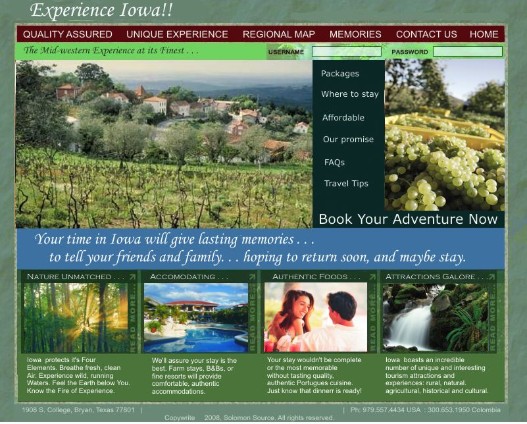
Diagram 7: Conceptual Web Mock-up for “Experience Your Region!” International Tourism Destination Market – (example provided, Quindio Colombia)
Initiative III. Developing New Technologies: Traveler Tourism and Community Network
What is the Traveler Tourism and Community Network?
The Traveler Tourism
and Community Network (hereafter Traveler Network) is a network of free-standing kiosks (or
panel displays) and virtual portals installed in various locations
throughout the
region (hotels, airports, attractions, etc.). A pilot project called
TexBox
Tourism and Community Network” was developed and deployed in
- a new “marketing” venue for rural communities and businesses interested in growing tourism.
- hubs for regional and community collaboration and networking.
- valuable capabilities to disseminate critical emergency/medical services to rural areas.
- a system to capture valuable information about the traveling public, their activities, preferences and feedback.
Introduction and Demonstration Project Overview
Proposed is the development of a demonstration version of free-standing computer information kiosk including: cabinet, computer hardware (CPU, touch-screen monitor, etc.) and software necessary to facilitate access to an online based system that will provide information to the traveling public. Initial information provided will include:
· Tourist
information (accommodations,
attractions, services, etc.)
· Weather
· Road
conditions
· Route
information
· Safety
Information
· User
surveys
· Emergency
services
· Interpretive
information about the area (natural, cultural, etc.)
· Local
industry contact information
Each chosen site will need to have Internet access available to the kiosk, preferably high-speed.
Justification
Travelers typically know little about the places they are traveling through. They also have questions that need to be answered (e.g. road conditions, weather, etc.). In conjunction with the efforts of various tourism development entities, this proposal outlines the creation of a network of digital information kiosks/portals that will provide answers to traveler’s questions.
Purpose
1) a complete “package” of answers to questions that traveler’s might
have,
The
purpose of the Traveler Network is to provide:
2) customized information about the places they are traveling through,
3) support for small businesses in rural communities and regions, and
4) contribute to coordination of tourism development efforts throughout the region.
The intent of the Traveler Network is to help the region and communities be better hosts to visitors and do a better job of “Marketing Your Region”. In addition, the Traveler Network can provide dynamic, interesting and timely information to users at locations where it is not practical to have the facilities staffed. In addition, the Traveler Network can serve as a template that can easily be adapted in other regions.
Steps in the Process
Dr. Skadberg and our regional contacts will perform the following tasks as part of this project:
- Conduct on-site reconnaissance and perform research in the areas and communities where the kiosks/portals will be.
- Contact communities located near each kiosk for assistance with gathering local information about attractions, accommodations and other pertinent information.
- Purchase, assemble and test the hardware, software and other equipment for the physical kiosk system (including the cabinet and any accessories).
- Research and identify Web based resources and information that will constitute the “informational content” of kiosk system.
- Develop Graphic User Interface (GUI) necessary to provide touch-screen access to information provided through the kiosks.
- Develop Web based resources (Web pages, text, graphics, maps, etc.) that will be stored locally on the computer CPU that will be housed in each of the kiosk units.
- Develop Web based resources (Web pages, text, graphics, databases, maps, etc.) that will be accessed from a Web server housed at a centralized location
- The final “pilot” product will present a prototype with some, but not all, of the information developed.
Benefits:
A Regional Tourism Development Hub?
The Traveler Network can become a tourism hub, creating a communication and collaboration network to assist communities and businesses to share information and resources. The Traveler Network is a system that can provide “marketing” exposure for rural communities to travelers who stop in communities and tourism attractions and Travel Information Centers annually.
Partners in the Traveler Network
A cornerstone of the Traveler Network is that the “content” of each will be developed and maintained by regional groups (local Chambers of Commerce, Convention & visitors bureaus, etc.) who live near the visitor facilities or attractions. Local responsibility can transform the project into a community grassroots-based effort. This design distributes responsibility of developing and maintaining the content to local groups who are one of the primary beneficiaries of the system, besides the traveling public.
Regional tourism destinations can become more important for nearby communities because the information technology infrastructure outlined in this proposal might very well establish regional and community tourism information centers as “Hubs” for community and regional tourism development. The Traveler Network can answer customer’s questions while it can also address several other important issues that are facing the tourism industry, rural communities, and citizens in the Department. A few of these are outlined briefly below.
Addressing the Needs of Both User Groups
The Traveler Network can help regions and the tourism agencies to satisfy the needs of communities’ and travelers. Communities need to promote their areas to the traveling public, and travelers need travel information and ways to find tourism opportunities. The Traveler Network accomplishes this while satisfying several goals for regions and states, its citizens, and the people that are visiting the country. A few of these include:
Easing Traveler’s—Travel Anxieties—Safety & Security
The Traveler Network will provide important safety and security information which can potentially reduce traffic fatalities and ensure that traveler’s concerns are minimized, while maximizing public awareness of safety issues.
Create Tourism Marketing Opportunities for Communities and Businesses
The Traveler Network will provide communities a way to attract travelers to spend some time in their region. Marketing for rural areas is constantly a challenge. The kiosks and portals at designated locations would provide useful information to travelers and create a new vehicle to reach potential customers who at the present time are driving by with little knowledge about the area.
Avoid Creating a New Government Agency or Bureaucracy
The Traveler Network will provide additional information without creating a need for additional on-site personnel. The design of the Traveler Network facilitates gathering information and providing a network for inputting, accessing and updating the information. The majority of content production and management will be the responsibility of the communities where the tourism kiosks are located.
Collect Important Information About Tourism’s Impact
Embedded in the Traveler Network kiosks technology are the capabilities to capture important information about users of the system. Several strategies have been developed and can be used to gather important information about tourism in the chosen region. In addition, this information will be invaluable to policy and decision makers (local, regional, national) and researchers interested in studying tourism’s impacts.
Internet Access Kiosk
Internet
access Kiosks will be installed in designated facilities in a well-lit,
secure
location. They will be secured to the floor to prevent theft. The kiosks
that
are being considered will be heavy-duty with durable components,
designed
specifically for use in areas without supervision. Other components such
as a security
camera will be included to discourage vandalism. An
example of a kiosk is shown in Diagram 8.
The kiosk will
be attractive with a modular
design. It will include the following
components:
1) Kiosk Enclosure
2) Color monitor (optional touch screen)
3) Computer CPU
with CD drive (up-to-date
processor and
RAM/ROM memory)
4) Durable keyboard
5) Durable trackball mouse (optional outdoor)
6) Camera7) Speakers/sound system
8) Internet ready with wireless capability
(optional wireless Internet "hot-spot")
9) Promotional space

Diagram 8: Example kiosk
Promotion and Public Relation Campaigns
Working in concert with the existing projects in the region, “Experience Your Region” will launch a public relations campaign to promote this project in a selected region, nationwide and internationally. It is likely that this project will be the first of its kind in this country and it will serve as a model for other states considering this type of offering. To sustain the positive publicity about this initiative, “Experience Your Region” (see branding discussion in Initiative II) will actively promote this service utilizing its media contacts and outlets and through its relationships with governmental offices, other businesses, tourism associations and other organizations.
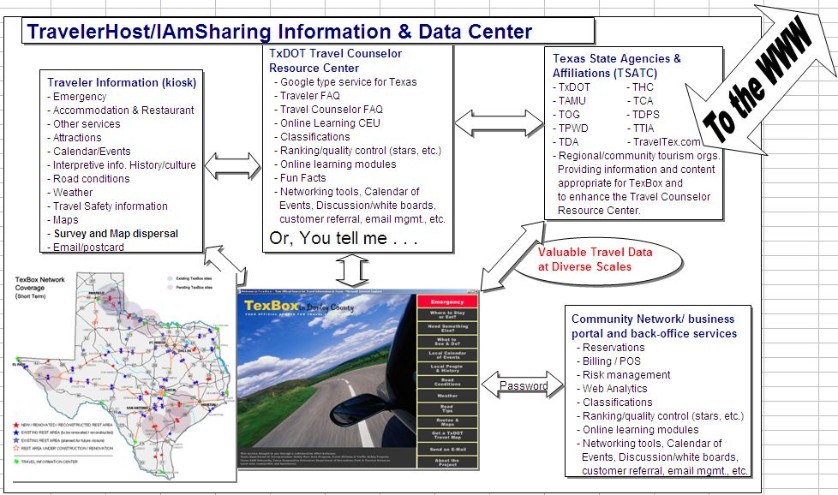
Diagram 9: Traveler
Network: Information and Data Center (example adapted
from TexBox project – 2003,
